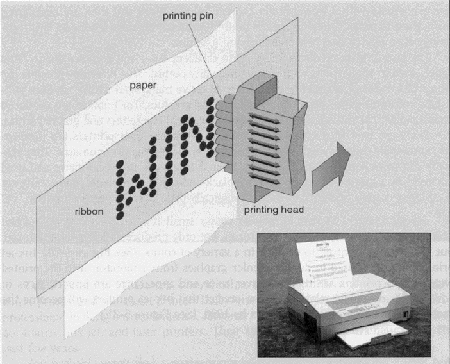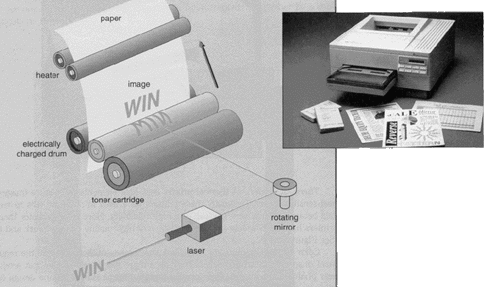Output Devices
The Monitor
This is the most commonly used output device. It displays what you have typed or otherwise entered in to the computer on the screen in front of you.Monitors can be monochrome (black and white, black and green or black and amber), or colour.
Colour monitors come in various types. Each type has a different number of colours to use and a different quality of picture (resolution). The higher the resolution, the better the quality of the pictures on the screen.
Resolution is measured in pixels. The screen is divided into a grid. Each square on the grid is a pixel. The more pixels are on the screen, the more detail can be shown in the pictures on the screen and the higher the resolution of the screen is.
CGA (Colour Graphics Adapter). These monitors have 4 colours and a very low resolution (320x200 pixels).
EGA (Enhanced Graphics Adapter). These monitors have 16 colours and a low resolution (640x350 pixels).
VGA (Video Graphics Array). These monitors come in two types. One is similar to the EGA monitor. It has 16 colours and a resolution of 640x4800 pixels). The other one has 256 colours and a lower resolution (320x200 pixels).
Super VGA. These monitors have very high resolution. They come in two types. Both types have 256 colours. One has a resolution of 800x600 pixels, the other of 1024x768 pixels. You can run the Super VGA monitor as a VGA monitor. This speeds up the time it takes the screen to display things as there are not so many pixels to be coloured in.
XGA (Extended Graphics Array). These monitors have 1024x768 pixels. It normally has 256 colours. With special equipment it can show up to 65,536 colours.
Most people will use a VGA or Super VGA monitor.
The Printer
This is the other common output device. It prints information and data from the computer on to paper. There are different types of printers.A Dot Matrix printer is an impact printer that forms characters as a series of dots. The print head contains a grid of pins which form a character. This heads stamps on to the paper through an inked ribbon to produce a character (for example, "H") that is made up of dots.
The print heads can have from 9 to 24 pins in them. The more pins the print head has, the better the quality of the printed output. Printers with 24 pins produce letter quality output.
The quality of the printed output is measured in dpi (dots per inch). The higher the dpi, the better the quality of the printed output.
Dot Matrix printers come with a standard parallel interface. They can also use a serial interface. Parallel interfaces are faster, but serial interfaces can be used over greater distances.
Impact printers are the only printers that will make an impression on carbon paper. Any printing that is done on paper with a carbon behind it or on self carbonated paper needs to be done on an impact printer for the printing come through on the second layer of paper.
An Ink Jet printer prints characters by spraying very fine jets of ink on to the paper. It works best with non-absorbent paper.
A Bubble Jet printer vaporizes part of the ink. The bubble that is created puts ink onto the page.
A Laser printer uses a laser beam to print. The laser creates an image on a drum inside the printer. This picks up toner and prints the image on to the paper like a photocopier does.
How Dot Matrix Printer Works.

How Laser Printer Works.
